
The House at 26 Francis Avenue in Wakefield, Massachusetts is a Colonial Revival octagon house. The shingle-clad wood frame house rests on a high fieldstone foundation, is 2 stories at its rear and 1-1/2 in front, and has the appearance of a square house with four square sections projecting diagonally from each of its corners. The house has a Craftsman/Bungalow-style hip-roofed dormer with diamond-paned windows, and its main entrance is oriented diagonally toward the corner, under a porch supported by round columns.
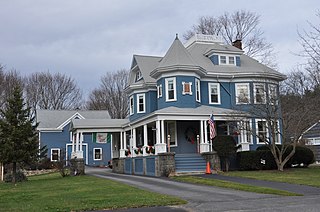
The House at 52 Oak Street in Wakefield, Massachusetts is one of the most elaborate Colonial Revival houses in the Greenwood section of town. The 2.5 story wood frame house was built in the 1890s. It has significant Queen Anne styling, including a turret and wraparound porch, but porch details such as the multiple columns on paneled piers are Colonial Revival in style, as are the hip-roof dormers. The house was built by Henry Savage, a developer with ultimately unsuccessful plans to develop the Greenwood area residentially in the 1880s.

The Hampton Inn, also known as The Maples Inn, is a historic former hotel property at 179 Oenoke Ridge in New Canaan, Connecticut. It is a three-story wood frame Colonial Revival structure, built in 1908 as a vacation boarding house. The house has irregular massing reminiscent of the Queen Anne style, with gabled dormers and projecting cross-gable sections, as well as a variety of porches. It is the only surviving building of its type in New Canaan.

The Frank J. Von Ach House is a historic building located on the east side of Davenport, Iowa, United States. It has been listed on the National Register of Historic Places since 1984.
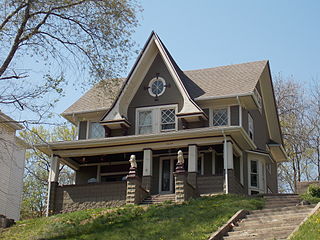
The Henry Ockershausen House is a historic building located in a residential-light industrial neighborhood on the east side of Davenport, Iowa, United States. It has been listed on the National Register of Historic Places since 1984.

The Elizabeth Pohlmann House is a historic building located in the West End of Davenport, Iowa, United States. Elizabeth Pohlmann was the widow of Herman B. Pohlmann, and she had this house built in 1896. The Pohlmann's were part of the German-ethnic community that lived on the northwest side of Davenport. The house features the hip roof and gable projections typically found in the Queen Anne style. But it also includes full cornice returns, which create pediments, and light colored brick typical of the Colonial Revival style. The 2½-story residence also features a main entrance framed by sidelights and an art glass transom over a plate glass parlor window. Both the front and the back of the house are missing prominent porches that were originally part of the structure. It has been listed on the National Register of Historic Places since 1984.

The Jonesborough Historic District is a historic district in Jonesborough, Tennessee, that was listed on the National Register of Historic Places as Jonesboro Historic District in 1969.

The Dr. Heinrich Matthey House is a historic building located in the Hamburg Historic District in Davenport, Iowa, United States. The district was added to the National Register of Historic Places in 1983. The house was individually listed on the Davenport Register of Historic Properties in 1993.

The William P. Warnock House, at 501 S. 5th St. in Enterprise, Oregon, is a 2 1⁄2-story historic house was built in 1910 and has been the largest house in Enterprise. It includes elements of Colonial Revival, Bungalow/craftsman, and Queen Anne architecture.
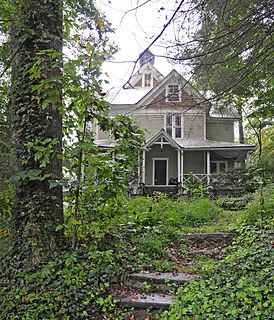
Charlton Leland, also known as the Dr. E.B Goelet House and Saluda Inn, is a historic home located at Saluda, Polk County, North Carolina. It was built about 1896, as a 2 1/2-story, Queen Anne style frame dwelling with a wraparound porch. It was enlarged and remodeled in the Colonial Revival style when converted to an inn in 1914. It rests on an ashlar-face stone foundation and is capped by a gable-on-hip roof with a prominent front gable. The building houses a retreat house known as the Saluda Inn.

The Williams-Wootton House, also known as the Dr. Williams Mansion, is a historic house at 420 Quapaw Avenue in Hot Springs, Arkansas. It is a 2-1/2 story masonry structure, built out of brick, with asymmetrical massing and a variety of projecting gables, sections, and porches typical of the late Victorian Queen Anne period. It has a rounded corner porch, supported by paired Tuscan columns in the Colonial Revival style. The house was built in 1891 for Dr. Arthur Upton Williams, and was originally more strongly Queen Anne, particularly in its porch styling, which was altered in the early 20th century.
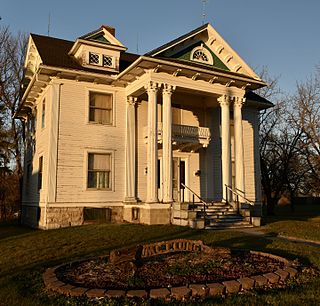
The J.J. McClung House is a historic structure located in Garden Grove, Iowa, United States. A native of Ohio, James Johnson McClung moved to Garden Grove in 1879. He owned and operated a livery and dray business, where he carried the mail from the train to the post office for 53 years. With the advent of the automobile, he built the first service station in Decatur County in 1925. The house was built from 1908-1909 by Wiley Sells of Leon, Iowa and remained in the McClung family for 80 years. It was added to the National Register of Historic Places in 1990.

The J.V. Banta House is a historic house located at 222 McLane Street in Osceola, Iowa.
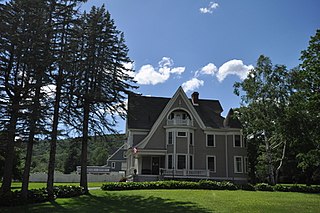
The Tudor House is a historic house on Vermont Route 8 in Stamford, Vermont. Built in 1900 by what was probably then the town's wealthiest residents, this transitional Queen Anne/Colonial Revival house is one of the most architecturally sophisticated buildings in the rural mountain community. It was listed on the National Register of Historic Places in 1979.

Sturdivant-Sawyer House is a historic residence located in Centerville, Iowa, United States. The house was built by Francis M. Drake, a former Governor of Iowa and founder of Drake University in Des Moines, as a wedding gift for his daughter Mary Drake Sturdivant. The Sturdivants owned house until 1908, and then again from 1914 to 1917. J. L. Sawyers, a Drake son-in-law, used the house as a medical clinic from 1908 to 1914 while he resided in the Drake House. Frank S. Payne bought the house in 1917. He was a local attorney who served two terms in the Iowa General Assembly, was president of Iowa Southern Utilities Company, and president of the Centerville National Bank. His wife, Grace, served in the leadership of various local women's organizations.

The C.H. Whitehead House is a historic residence located in Marshalltown, Iowa, United States. Whitehead was a Boone County, Iowa native who came to Marshalltown in 1898, where he established a women's and children's clothing store that is thought to be the first of its kind in Iowa. He had this home built around the turn of the 20th century. The house does not exemplify any one style, but is a compilation of several styles. The Queen Anne style is found in overall asymmetry of the main facade, especially the projecting bay and the porch's pediment, as both are off-centered. The Georgian Revival style is found in the rectangular form of the structure, the horizontal proportions, and the Adamesque details. The 17th century colonial architecture of New England is found in the way the second floor overhangs the first floor on the side elevations. The house was listed on the National Register of Historic Places in 1979.

The Thomas E. Cavin House is a historic building located in Council Bluffs, Iowa, United States. Built in 1887, it is an unusual and well-preserved brick example of an eclectic combination of Colonial Revival, Gothic Revival, and Queen Anne architectural elements. Cavin owned a dry goods store nearby. He lived here until he died in 1911, and the house remained in the family until 1919. At some point it had been converted into apartments. The house was damaged in a fire in 1934, and had to be partially rebuilt, especially the roof. The front porch is not original.

The Henry Weis House is a historic building located in Waterloo, Iowa, United States. Weis was a factory owner that produced egg case fillers, which were used to protect eggs during shipping. He engaged the local architectural firm of Murphy & Ralston to design this house, which was completed in 1902. Architecturally, the two-story frame structure is "transitional" in its design, featuring elements of the Queen Anne and the Colonial Revival styles. The Queen Anne is found in its irregular plan, wraparound porch, full-height bays, small second floor porch, and the small screened porch. The Colonial Revival is found in the Ionic fluted porch columns, and the consoles with a row of dentils located along the cornice. The house also features foliated designs on the gable ends. It remained in the Weis family into the 1930s when it was converted into apartments. It has subsequently been converted into a bed and breakfast. The house was listed on the National Register of Historic Places in 1989.
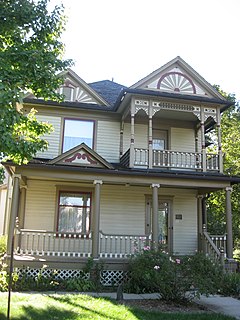
The Henry T. and Emilie (Wiese) Henryson House, also known as the Bartlett Museum, is a historic building located in Story City, Iowa, United States. It is a fine example of the spindlework subtype of the Queen Anne style, and the best remaining example left in the community. It also reflects the growth and development of Story City by Norwegian immigrants in the early 20th century. This two-story frame house was built in 1903. It features an asymmetrical facade and a full width front porch on the main floor with second-story porch above the main entrance.

The Richard T.C. Lord and William V. Wilcox House is a historic building located in Des Moines, Iowa, United States. This 2½-story dwelling follows a crossed gable plan that features elements of both the Colonial Revival and Queen Anne styles. The Colonial Revival influence includes grouped round porch columns and a pedimented porch entry. The Queen Anne influences include its massing, the brackets at the gable end, the second story corner porch, bargeboards, shingles, and the large porch. The property on which it stands is one of ten plats that were owned by Drake University. The house's significance is attributed to the effect of the University's innovative financing techniques upon the settlement of the area around the campus. Lord was a realtor, one of the organizers of the University Land Company, and he was a member of the first Board of Trustees of the University. He lived here from 1888 to around 1890 when he sold it to W.V. Wilcox, an insurance agent for Hawkeye Insurance Company. The house was listed on the National Register of Historic Places in 1988.





















